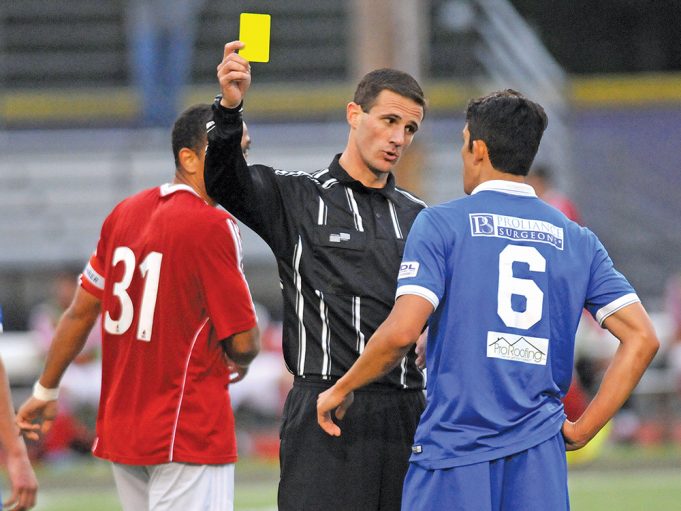Warnings done correctly can be very useful, but if they are used in the wrong situation, they can hurt more than they help game control. I had an instructor who would frequently say, “If you warn a player, the guy he just knocked down is going to think that, if all the player gets is a lecture for sore ribs, I will do that too.”
The reason that a referee may want to talk to a player is that showing cards too often diminishes the value of the caution, so a warning can save you from cautioning. The comment above is saying that warnings should be used only for offenses that are just a bit over the limit.
In a game I witnessed, goalkeeper A1 comes out and fields a bouncing ball near the top of the penalty area. Striker B7 runs at the goalkeeper, veering off at the last second and not making any contact. The referee took no action. The purpose of this was to intimidate the goalkeeper.
This goalkeeper did not intimidate well. B7 did the same thing a couple of minutes later. As he ran close to the keeper, the keeper grasped the ball in both hands and stuck out his elbow and B7 now has sore ribs. This is allowing the players to control the game, just like asking the devil to protect you from evil.
The referee could have shown a card for unsporting behavior. I suggested that, after the first incident, the referee tell the goalkeeper to just hold the ball for a moment. Go to the attacker and quietly suggest he not do that again because it is likely to cause problems in the game and he is not going to be allowed to intimidate that goalkeeper with such tactics.
The goalkeeper may not know exactly what is being said, but he should understand that the referee is addressing the issue. Such warnings tell both players that the event was more than you wanted and things need to settle down. It may also tell a player that he is committing too many fouls (thus approaching “persistent infringement”).
A warning depends a great deal on the temperature of the game
The line between where you would show a card and just give a warning depends a great deal on the temperature of the game. If the game is well under control with few fouls and no or only a few cards, you would be more likely to warn rather than card.
If fouls are coming quickly at a rate faster than they should and/or are overly hard and you have already shown three or four or more cards, the game is heating up too much and it is too late for a warning. And if the foul was hard or tactical, a warning is not going to be seen as adequate for the victims.
If the game is having serious control problems and the yellow card is not getting respect, you may want to up the ante. A comment loud enough to be heard, saying something like, “You guys are not paying attention to the yellow card but I have a red one too” may get them to become more attentive.
There are different ways to give warnings
There are some different ways to give warnings. The “quiet word” is just a brief, private conversation, perhaps as you go by the player, letting him know that what he did was more than you want and he needs to calm down. If the game has not gotten too hot, this can be very effective.
If the foul was harder and/or things have heated up, you may want to take a few moments and talk to the player more publicly to let both sides know something is being done. If what is being said is quiet, it allows you to say things you would not want to say publicly. I know one fellow who said after hard contact, “I don’t think you did anything wrong, but the other team expects me to do something.” Perhaps something like, “That wasn’t as bad as it looked, but let’s tone it down” is better.
If the foul was quite bad, you may want to be louder. Some referees like to use firm gestures along with a conversation when they feel a public warning is the better way to handle the incident. You must make it clear to everyone that better behavior is needed.
Use these or variations to keep the game on the right track. Much depends on how serious the incident was and some on how you communicate with others.
What's Your Call? Leave a Comment:
Note: This article is archival in nature. Rules, interpretations, mechanics, philosophies and other information may or may not be correct for the current year.
This article is the copyright of ©Referee Enterprises, Inc., and may not be republished in whole or in part online, in print or in any capacity without expressed written permission from Referee. The article is made available for educational use by individuals.


















